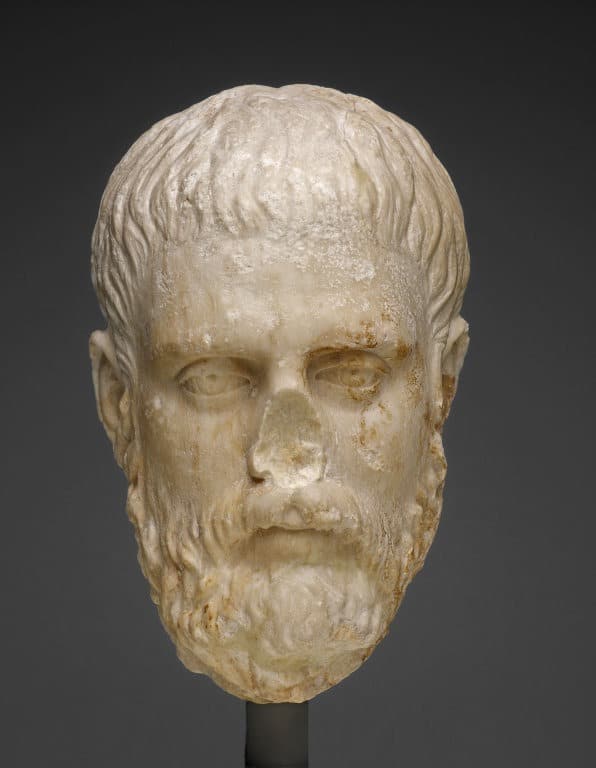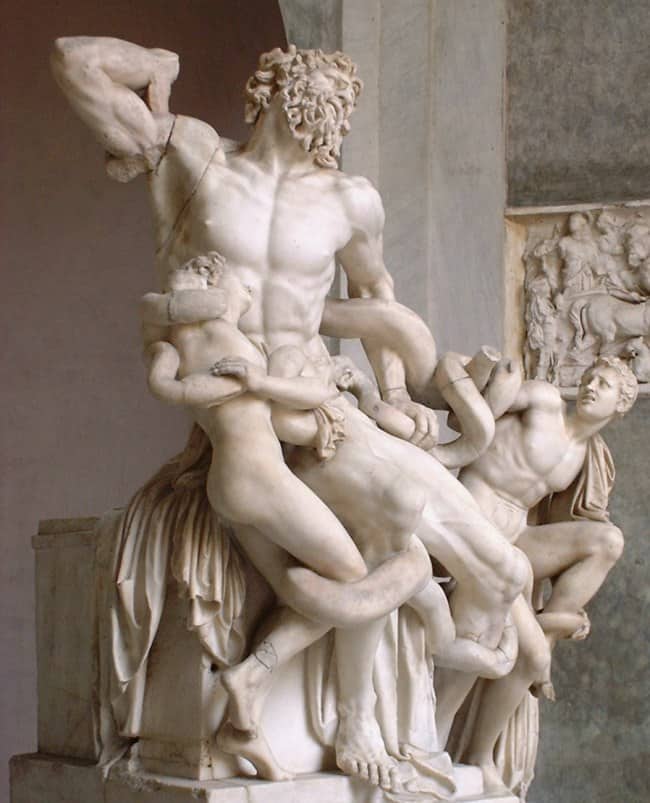4th Grade Art Appreciation: Classical Art · Craftwhack

Nosotros are embarking on an exciting topic with this presentation… expect for information technology….. Classical Greek and Roman Art!! (I suppose the title of the post already gave it abroad. Oh well.)

Discobolos (Discus Thrower), Myron, life-sized, 450 BC
Questions to Enquire the Kids:
- This is a life-sized statue made in ancient Greece (450 BC) by the sculptor Myron. A discus is a round stone slab.
- What is going on hither?
- What would happen next?
- Does this action await natural? Why?
- Does the shape of the body and the muscles look normal or correct?
- Does this man look like a real person? How tin you tell?
- Does he await superhuman?
- Does anything not look natural? What about the hair?
Background Information (for the presenter):
Greek sculptors wanted to represent a natural grade moving in space at a moment in time. They studied the beefcake of the human body. Equally a consequence, for the offset fourth dimension in history, artists created sculptures that seemed as natural as human being beings.
Myron was the first of the great sculptors to to bring motion to his sculptures. The power and tension in motion seem then real here that we experience we need to motion aside to avoid being struck when the discus is let go. The proportions of the body are correct and testify a keen understanding of bone and muscle in the motility of the trunk.
The Greeks loved art and poetry and greatly admired skill in athletics. The city-states of Greece competed with each other not only in trade simply in decorating their cities with the nigh beautiful statues and paintings, and in winning the most prizes at athletic meetings or games. The Olympic games originated in Greece in 766 BC.

Head of a Philosopher, 400-375 BC, marble, AIC
Questions to Enquire the Kids:
- How is this head of a philosopher, which is at the Art Institute of Chicago, similar to the statue we just saw?
- Why do you lot call up it is broken?
- What kind of expression does this human have? Does he look real? Or natural?
- Exercise y'all think this was an exact likeness of a particular man? Why?
- This is carved from marble. Practise you lot recall that carving in marble is easy or hard?
- A philosopher is someone who likes to call back near things similar why are we here? What are we doing here? What is the meaning of life?
- What do y'all think this philosopher is thinking about?
Background Information (for the presenter):
We must call back that these statues are over 2,000 years onetime and many of them are cleaved. Most Greek statues were painted with bright colors originally, but through time, these colors have worn off. How different they must take looked when painted.
Statues the Greeks made were not of any ane particular person. They made statues showing the nigh admirable characteristics of all human being beings. We say their art is idealized; they showed only the most perfect and beautiful images of their models. This sculpture is at the Art Institute of Chicago.

Nike of Samothrace, 200-190 BC, marble
Questions to Enquire the Kids:
- Do you see activity in this sculpture?
- What do yous think is happening? How can you tell?
- Have yous ever seen anyone with wings?
- Do you call up she is real or fabricated up?
- Do you call up her clothes look existent or that robes would mantle like that on you lot?
- Why do you recollect her clothes are and then tight on her? Does it have some connection with the wings?
- What would your clothes look like if you lot were flying through the air?
- Are her proportions correct?
- Why exercise you think the shoe company Nike chose the name Nike for their shoes? Is it a good name? What do yous recollect the Nike shoe company is trying to tell u.s.a. well-nigh their shoes?
Groundwork Information (for the presenter):
This is a sculpture of the Greek winged goddess of Victory, Nike, constitute on Samothrace, a Greek island in the Aegean Ocean. Manifestly, parts of her are missing. Originally she was displayed with a pool of h2o around her so that it looked like she was landing on the prow of a ship. The sculptor has captured the drama of swirling winds filling Nike's wings and pressing her robes tightly against her body, which looks beautiful, graceful, and natural.
According to the Greek myths (traditional stories of Hellenic republic), Nike was the Goddess of Victory. The Greeks believed in a large family of gods who were very much like humans; they did not worship brute gods. Each god ruled over a dissimilar part of human life. Nike was the goddess of Victory. This statue is at the Louvre Museum in Paris, France.

Laocoon Group, 175-150 BC, marble
Questions to Ask the Kids:
- What is happening here?
- Is there a lot of action going on in this sculpture?
- What is it that adds to the action? Is in that location tension here?
- Do y'all think this would look as exciting from the sides or the back? Why?
- What do you think is going to happen to these people?
- Do yous call up they will get abroad?
- Practise they expect like real people?
- Do you think their proportions and musculus structure is correct? Does it look normal or super-human?
Background Information (for the presenter):
According to the Greek myths, Laocoon was a priest of Apollo at Troy who warned the Trojans against the Trojan Horse. With his ii sons, Laocoon was killed by serpents sent by Poseidon, God of the Sea.
This sculpture shows the groovy understanding the Greeks had for human anatomy and their appreciation of the workings of the bones and muscles in movement.

Portrait Head of a Man, AD 50, Roman, marble
Questions to Ask the Kids:
- Does this expect like the caput of the philosopher we saw before?
- What is unlike about it?
- What kind of expression does this man have or what kind of mood is portrayed?
- Can you tell his age? How?
- What else tin can nosotros tell nearly him?
- Practise y'all think this is a likeness of a particular human being? Why?
Background Information (for the presenter):
For the most part, the aboriginal Romans imitated the art of the Ancient Greeks. Roman art in many ways is a continuation of Greek art. Nearly of what nosotros know of Greek sculpture, for example, comes from the copies of Greek originals that were manufactured for the Roman marketplace. The Discus Thrower is a Roman copy.
The Romans did add their contributions in the many sculptured portraits that they made. The platonic image of the Greeks was replaced past a realism that showed every wart and sagging muscle. In this portrait of a man, what looks different from the Greek Caput of the Philosopher?
Hither we don't see the ideal face of a human, simply a realistic look of a human showing his particular characteristics and the furrows in his confront. This sculpture is probably very much like the man who sat for it.
Here'southward your Powerpoint version of Classical Art if you prefer to have this show on the road. Show people everywhere! Give everyone the gift of an art appreciation lesson!
Hither are the rest of the K-5Art History for Kids presentations.
Source: https://craftwhack.com/4th-grade-art-appreciation-classical-art/
0 Response to "4th Grade Art Appreciation: Classical Art · Craftwhack"
Postar um comentário